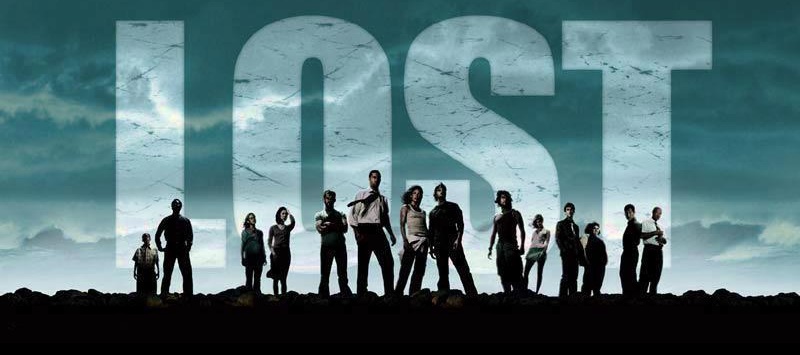
After two weeks of talking little other than Marvel UK, let's move back across the pond and talk about one of the great 90s icons of Marvel US - Ghost Rider! 

As usual the focus of this thread will be on the 90s years of the character, but in order to understand that era, let's start with a little history.
It may or may not be something you know, but the concept of ghostly huntsmen streaking across the night sky, always on the hunt for mortal prey or supernatural enemies is a mythic motif that stretches far back into the fog of prehistory. 

Many cultures have their own legends of these ghost riders, often called the Wild Hunt, and various ideas of their origins and purpose. In northern Europe, they are often attributed to the Aesir god Odin and can be either beneficial or dangerous. 
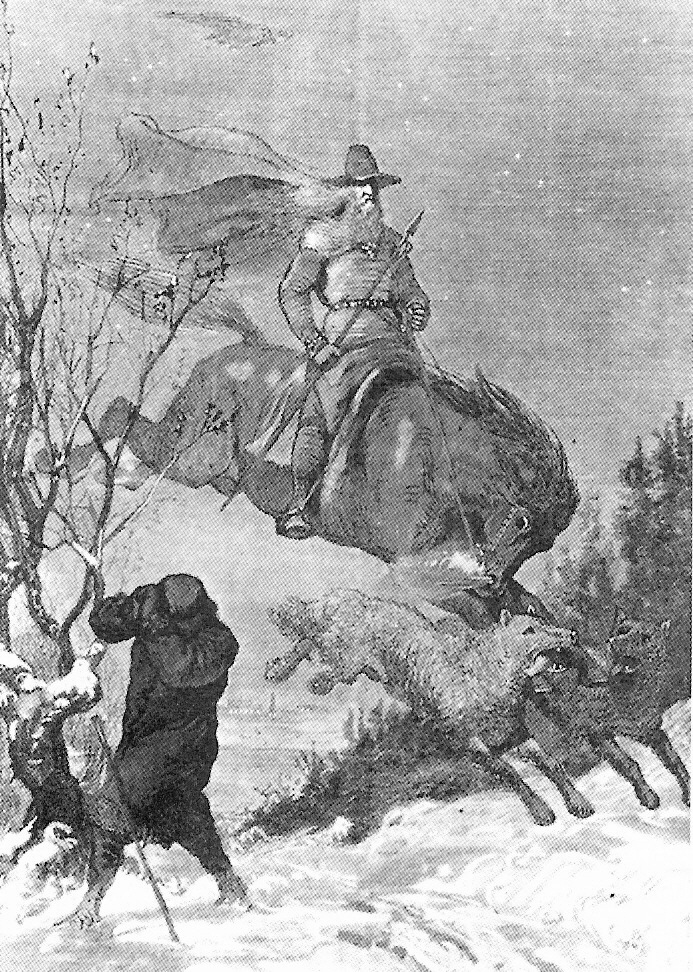
When European immigrants took their folklore to the new world, the wild hunt went with them, and in the rural wild west the ancient myth took the form of stories of ghostly cowboys or ranchers driving cattle forever across the sky. 

Attested across the US and neighboring country, the myth of the restless spirit riding forever grew from the legend of the divine hunt, and so ghost riders became a small but significant part of the ghost story folklore of the Americas. 
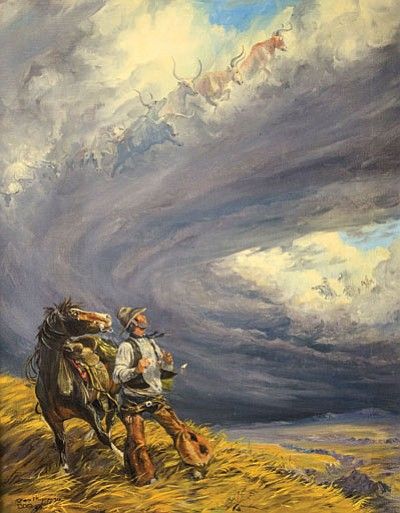
In 1948, a country and western singer-songwriter named Stan Jones composed and released a song called "Ghost Riders in the Sky". This was far from the first use of the term in pop culture, but the song was a smash hit and continues being played and covered today. 

The song even inspired a movie, though it dropped the "ghost" part of the title (which many later releases of Jones' record also did). Starring legendary singing cowboy Gene Autry, the movie had little actual supernatural content. 

Perhaps it was inevitable that the Ghost Rider concept would cross into the burgeoning world of comics, as both western comics and supernatural avengers like the Spectre were already going into that territory in the early 1940s. The idea would take a long while to gestate, tho. 

In 1949 a publisher called Magazine Enterprises introduced a character called the Ghost Rider in their line of western comics. Created by Ray Krank and Dick Ayers, the comic followed a cowboy named Rex Fury who was visited by the spirit of "Wild Bill" Hickock... 

Fury was trained by Hickock and other spirits of dead Western heroes to return to the land of the living as the Ghost Rider.
Magazine Enterprises did not last long however, and the title vanished into obscurity.
Magazine Enterprises did not last long however, and the title vanished into obscurity.

There are many more cowboy heroes and supernatural avengers following this Ghost Rider, but for brevity's sake we will jump forward to 1967.
Inspired by the song, Roy Thomas, Gary Friedrich and Dick Ayers launched a new Ghost Rider title at Marvel, following the success of many titles such as Two-Gun Kid and Rawhide Kid. This was a new character, though he shared the looks of the original incarnation. 

This Ghost Rider also had a near-death experience, but his powers were strictly mundane, coming from a form of paint that made him glow and also could render him partially invisible. His private identity was Carter Slade. 

Slade's tenure as Ghost Rider was relatively brief by Marvel standards. By the early 1970s western titles were quickly waning in popularity, and with his title canceled, Slade perished in Western Gunfighters #7, leading to a series of successors to continue his name. 

A side note: Ayers worked on most of Ghost Rider's appearances during this era, a nice consistency for a character he designed... twice.
Gary Friedrich was not done with the "Ghost Rider" concept yet, however. Less than a year after Slade's death, Friedrich together with artist Mike Ploog introduced a new horror-themed Ghost Rider, this time set in the scintillating seventies. This was the advent of Johnny Blaze. 

Debuting in Marvel Spotlight #5 (72) before quickly graduating to his own comic, you probably know Blaze's legend already. A stunt cyclist who makes a deal with the devil in order to save the life of his adoptive father, only to find himself imbued with a demonic alter ego... 
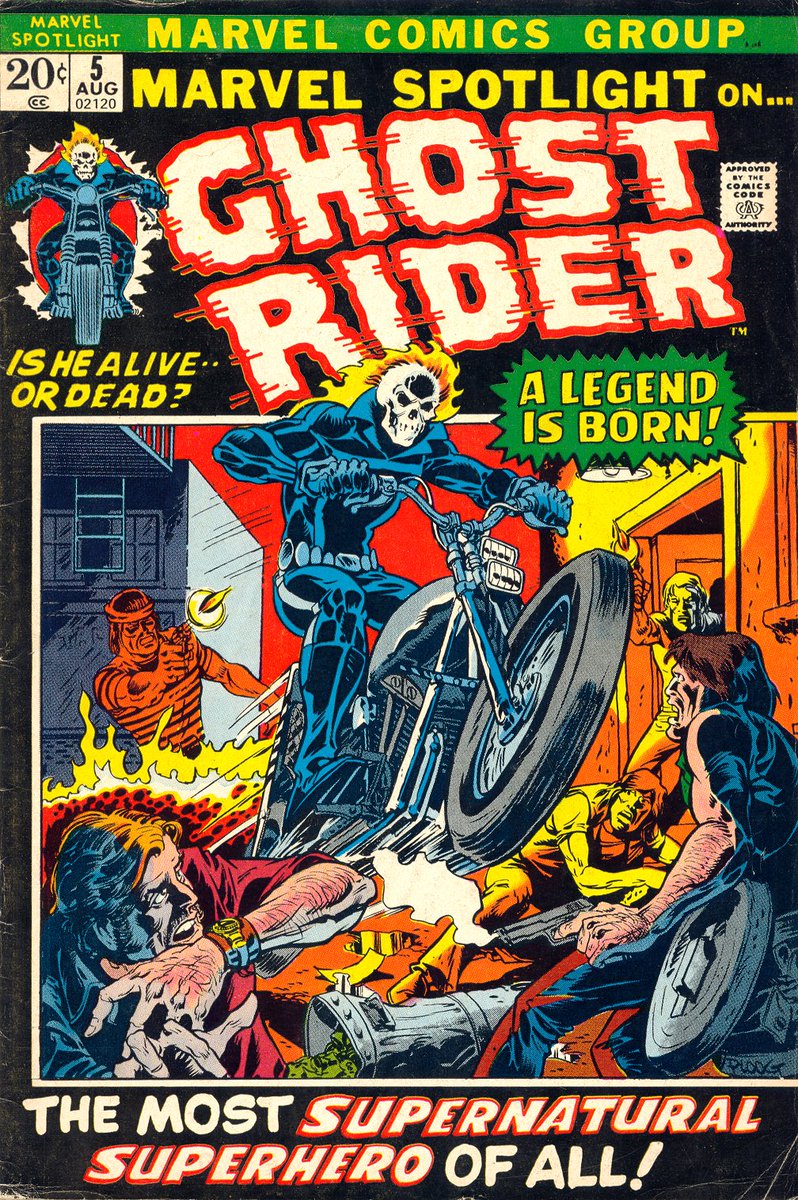
With Crash Simpson dying in an ill-advised stunt anyway, Blaze's bargain is technically fulfilled and he is doomed to become Ghost Rider forever, acting as a magnet for supernatural threats while fighting the forces of Satan. 

The horror vogue of the 1970s, combined with the dwindling power of the Comics Code Authority, allowed Marvel to really exploit the horror genre with titles like Ghost Rider, Tomb of Dracula, Werewolf by Night and others, the protagonists of which often crossed over. 

Many retcons would affect the character even during this first run, including revealing the "Satan" he made a deal with was Mephisto, and revealing that the Ghost Rider entity was actually Zarathos, an ancient rival of Mephisto that the arch-demon imprisoned in mortal flesh. 

Despite a long run, horror was on the way out by the end of the decade, and though he held on until 1983, Johnny Blaze's long ride ended with issue #81 of his solo title, where he was actually freed of Zarathos to live a normal life! 

If it sounds weird that Marvel would so solidly just end a character's journey, that's because mores of superhero comics have changed. In the 70s and 80s, it wasn't uncommon for the final issue of a run to actually end the story, retiring or even killing the main character.
Power Man and Iron Fist #125 ended with Iron Fist dead and Cage on the run from the law, accused of his murder. Spider-Woman #50 ended with Jessica Drew dying to defeat her greatest enemy Morgan le Fay. Bill Foster had to give up his powers as Giant-Man and retired. 

And so for 7 years, Ghost Rider was nothing but a past hero, a fondly remembered supernatural avenger of yesteryear while Johnny Blaze married his girlfriend Roxanne and lived out a normal life. Until...
The year is 1990. Horror is back in style, now in the form of urbanized horror with supernatural threats lurking in modern cities and towns. Howard Mackie and Javier Saltares team up and relaunch Ghost Rider with an all-new issue 1, and an all-new premise. 

Perhaps this legend is also familiar to you. Danny Ketch is just a regular young man in New York city visiting Cypress Hill Cemetary with his sister Barbara. In a confrontation between the Kingpin's men and a mysterious new villain named Deathwatch, Barbara is mortally wounded. 

Desperately running, dragging his sister with him, Danny finds an old, abandoned motorcycle and happens to put his hand on the glowing medallion on it. And thus, a new Ghost Rider is born, darker, edgier and more violent for the new era. 
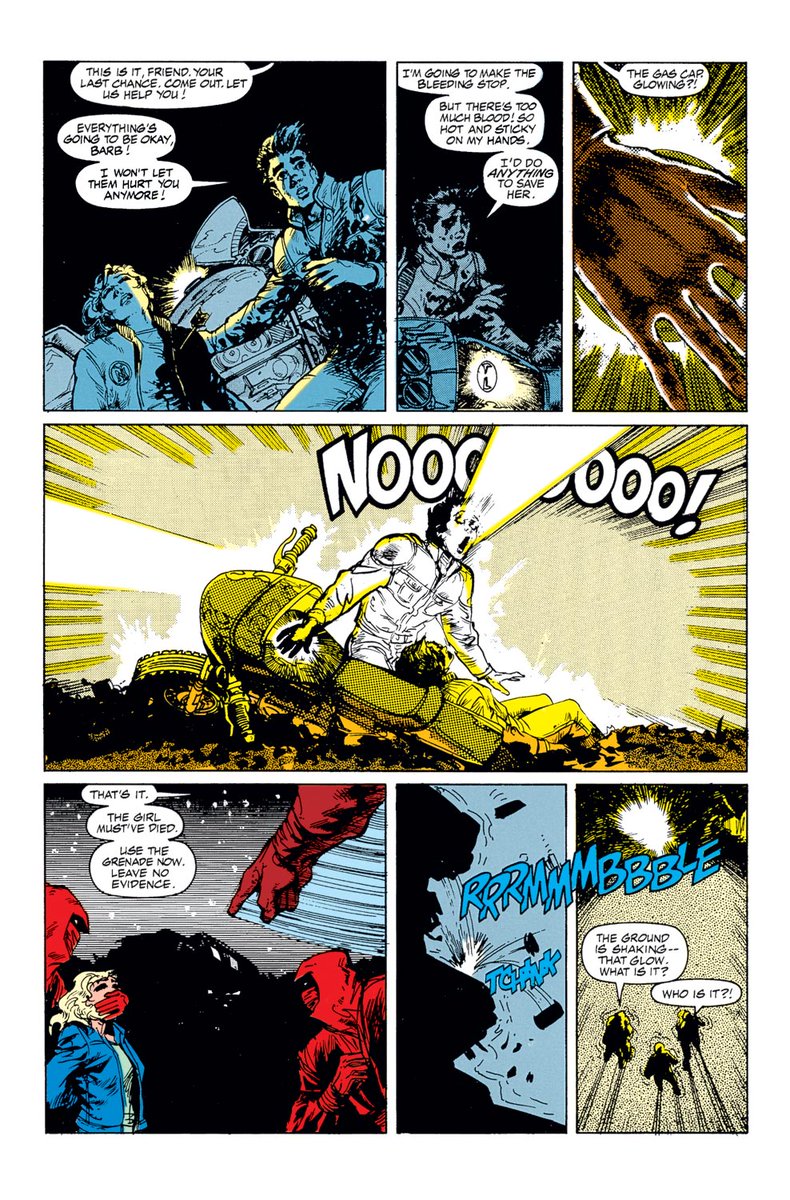
It's important to note that a lot of the ideas we today consider iconic of Ghost Rider come from the 1990s reboot. His useage of chains as weapons, the bike being a physical thing rather than a mundane bike imbued by hellfire, and of course... 

...the much-ridiculed penance stare.
Allegedly a fearsome ability, this power seems to always fail against dangerous villain for some silly reason or the other, though it was rather more effective during Danny's first years.
Allegedly a fearsome ability, this power seems to always fail against dangerous villain for some silly reason or the other, though it was rather more effective during Danny's first years.

Ghost Rider was an unexpected but huge hit for Marvel. With inker Mark Texeira taking over the art it only grew more popular, often winning popularity polls and ranking high in the sales charts. Clearly Marvel had a hit on their hands. 

Less than a year into his arrival on the scene, Danny Ketch was a popular guest star in Marvel titles across the board, even popping up in Todd McFarlanes adjectiveless Spider-Man in a two-part arc which doubtless further boosted his popularity. 

As early as 1991 the popularity of Ghost Rider and his cameos was rife for spoofing when Walt Simonson and Art Adams made him a member of the "New Fantastic Four" for one hilarious arc, together with Marvel's other cameo superstars Wolverine, Spidey and Hulk. 

While sometimes his cameos were frivolous, Danny's own title was very heavy on the grim and bloody tone it had established. His villains were genuine monsters like the death-consuming Deathwatch and the monstrous Blackout, and blood and death were everywhere. 

While any connection to the past Ghost Riders seemed nebulous at first, a storyline beginning in #10 (91) reintroduced Johnny Blaze, who thought the new Ghost Rider was his old demon Zarathos back on the mortal plane and traveled to New York to kill or imprison him again. 

This culminated in issue #14, where Johnny and the new Ghost Rider clashed, ending with Blaze learning that somehow Danny's transformation was totally unconnected to Zarathos. This along with an earlier team-up with Doctor Strange set the stages for Ghost Rider... 

...expanding from a single title into a whole "family" of titles in the style of Spider-Man and the X-Men. And thus the seeds were planted for... 

A mystery box is a narrative device where a series starts off by introducing one or many mysterious, unexplained elements as important parts of the setting. Ideally, as the series progresses these mysteries will gradually be peeled away, leading to cool revelations...
...and giving the person experiencing the story a sense of discovery and satisfaction. Characters and situations are cast in a new light and the thoroughline of the story is suddenly apparent, leading to a holistic narrative.
The Black Isle game Planescape Torment (99) begins with your character amnesiac on a slab in a morgue, and leaves you to try to piece together how you ended up there and why you are effectively immortal. This game serves as an excellent use of mystery box storytelling. 

The television show The X-Files (starting in 1993) sets up a huge amount of mystery boxes at the start and either never resolves them or backtracks and tries to restore resolved mysteries to maintain a popular status quo. This is a bad use of mystery boxes. 

How is this relevant? Because the 1990s Ghost Rider run was riddled with mystery boxes that either were never resolved or petered out until people no longer cared. Howard Mackie seems to love this kind of story as he has also used it for other titles he's written. 

By 1992 the preparations for the supernatural "family" of titles were ready and with issue #28, the Rise of the Midnight Sons crossover began. 
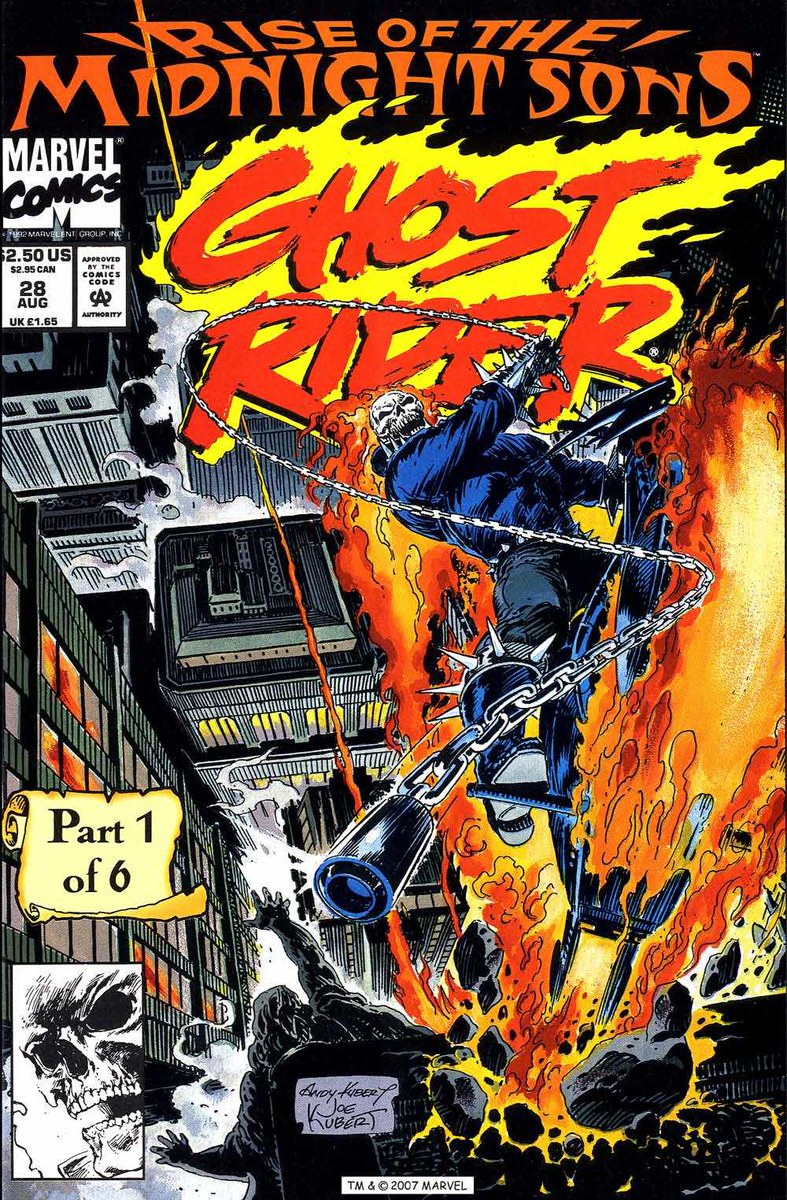
Primeval demoness Lilith and her brood the Lilin arise once more, and earth's supernatural defenders must band together to stop her. Other than Ghost Rider, the event launched three more titles. 

Ghost Rider/Blaze: Spirits of Vengeance served as a Blaze title with Danny Ketch pinch-hitting as the duo took on various major threats. 

Nightstalkers teamed up three supporting characters from the classic Tomb of Dracula to fight vampires and other creatures of the night, including reintroducing future movie superstar Blade. 

Morbius was the first solo title of the Spider-Man villain/anti-hero, now off on his own adventures. 

Darkhold, finally, was a quirky horror comic about the ancient tome introduced decades earlier, following the havoc caused by its scattered pages and the efforts of the Darkhold Redeemers to prevent it. 

Serving to introduce a dozen new heroes and villains, this crossover was a concerted effort to establish a supernatural sub-universe in the greater Marvel U, and was very much in the spirit of the times given the popularity of urban horror in the early 90s.
Where DC was approaching horror as a mature concept with their nascent Vertigo titles such as Sandman and Hellblazer, Marvel approached it as a different setting for over the top superhero action, with none of the retrospective nature of the DC titles.
I'm not saying either approach is bad, they're just two totally different ways of handling the idea of horror concepts in a larger shared universe.
At this point it seemed like the Ghost Rider titles were still moving forward. Danny had memorably defeated his arch-enemy Deathwatch and seemingly destroyed him, though we never learned any of the mysteries behind Deathwatch's origins in that arc. 
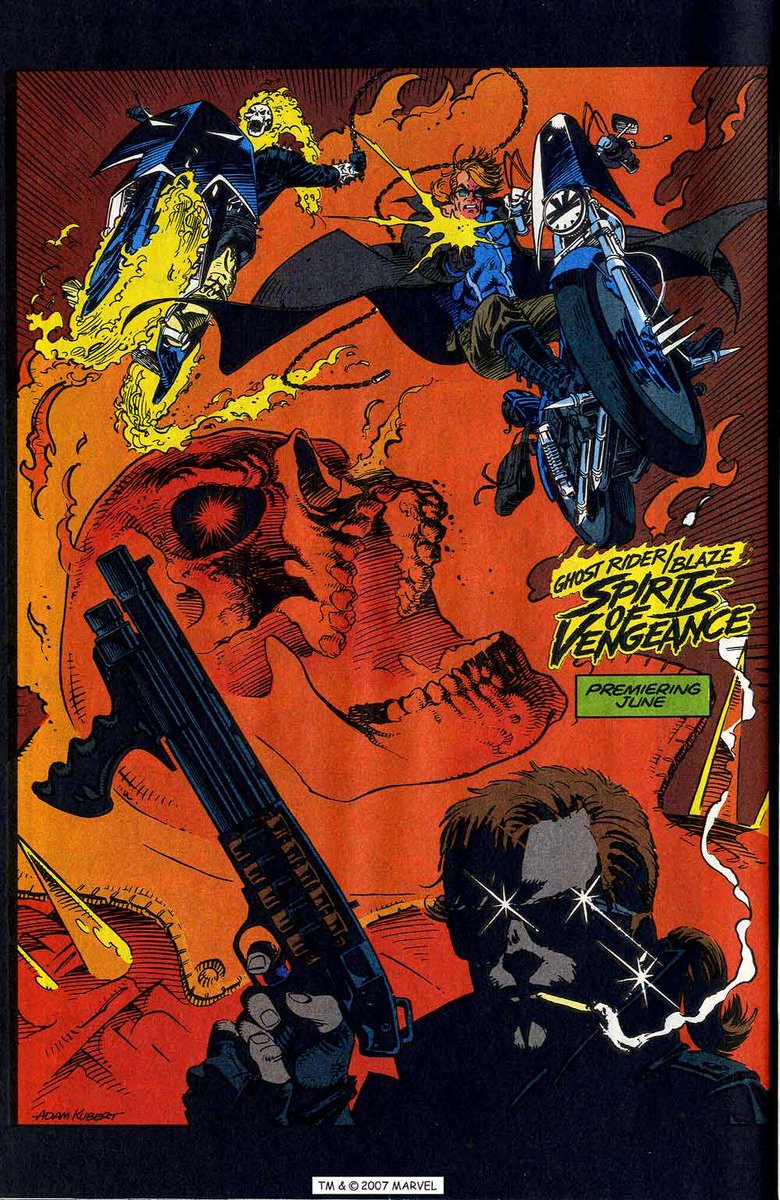
Issue #28 also introduced the Caretaker, a mysterious man who seemingly had answers about Danny's demonic nature and a mysterious connection between Danny and Johnny which neither knew about. He also refused to elaborate on this for quite some time appearing to drop cryptic clues 

In 1993 the Midnight Sons titles ran a second crossover, the Midnight Massacre. In it, Blade got hold of one of the Darkhold pages which provoked him into slaughtering all supernatural beings, even his allies. 

In the very next issue after the conclusion of the Midnight Massacre (Ghost Rider #41), another crossover story called Road to Vengeance kicked off, featuring some extremely garish neon ink covers. 

Ghost Rider's title had featured quite a few 90s gimmicks already with foils and embossed covers and such. Truly following the trends of the day.
Anyway in Road to Vengeance, Zarathos reappeared and teamed with Lilith, and Danny and Johnny only barely defeated the two. The story ended with Caretaker FINALLY telling them that they are brothers, which seems like a rather cliche revelation. 

I want to reiterate that at this point, 3 years into his run, Ghost Rider had made a truly staggering amount of cameo appearances. He'd been featured in all the major Marvel titles of the time and was one of the "faces" of the company, often parodied and mocked by other publisher 

He also appeared in the Marvel animated shows of that era, cameoing in both Fantastic Four, X-Men and Hulk, though not much is explained about him in those episodes. 

Mackie had even introduced yet another mystery box - the character of Vengeance who was essentially the Venom to Ghost Rider's Spider-Man. A mysterious individual empowered by mysterious means to transform into a bigger, meaner, more evil version of the spirit of vengeance. 

If your immediate reaction to that is "that sounds ridiculous"... it kinda was. And Vengeance having a very strange design certainly didn't help. Another truly bizarre idea was that Blaze was transformed into a cyborg during Road to Vengeance. 

The Midnight Sons had also received their own quarterly oversized comic in Midnight Sons Unlimited, but the line was overall not doing great. People just didn't seem interested in the spin-off supernatural titles. 

And so at the end of 1993 (right after Road to Vengeance concluded for Ghost Rider) Marvel kicked off YET ANOTHER crossover, this time the 17-part "Siege of Darkness" which would redefine the supernatural titles for the future. 

This crossover was extremely bloated and featured many different plot threads, including making the Doctor Strange title into a Midnight Sons book and bringing Scarlet Witch in for a bit. Overall it was not well-received. 

Darkhold ended with the crossover while Nightstalkers limped along for a few more issues before folding. Spirits of Vengeance lasted for six more issues, eventually leaving only Ghost Rider itself, Morbius and the now rebranded Doctor Strange as the survivors. 

You will notice that with four crossovers within the span of 2 years (not counting cameos in line-wide events like the Infinity saga), Ghost Rider had become an extremely fragmented title. It rarely had time to progress uninterruped anymore as it had at the start, and...
...revelations and resolutions became more and more sparse. The revelation that the medallion on Ghost Rider's bike was a family heirloom and also empowered Vengeance in Siege of Darkness was almost forgettable. And with the other Midnight Sons titles folding, the downward spiral
...continued.
It has often been speculated that a Ghost Rider cartoon was planned due to his many cameos in other shows and that he received a toyline of his own in 1995, but nothing ever came of it.
It has often been speculated that a Ghost Rider cartoon was planned due to his many cameos in other shows and that he received a toyline of his own in 1995, but nothing ever came of it.

Blaze briefly spun off in his own title in 1994 which ran for 12 issues where the character's cybernetics had been removed and he sought his missing wife and children which had been abducted during the Spirits of Vengeance title (in between crossovers). 

Ghost Rider #53 was the final issue to bear the Midnight Sons logo, and that period for the title was slightly promising as the intrusive crossovers were gone and it was back to more character-driven stories featuring old villains like Blackout (no longer a mere lackey of Lilith) 

Danny also found himself hunted by his girlfriend Stacy Dolan, a New York cop who had come to believe Ghost Rider to be a threat. 

Howard Mackie's final issue of Ghost Rider was issue #63 in 1996. The title has survived the implosion of its own sub-universe and the death of many other titles, but it was clear that Mackie was done. 

With issue #70 new writer Ian Velez Jr arrives on the scene and IMMEDIATELY starts untangling the plot mess of the previous six years, leading to a rapid-fire period of plot development. 

The flashback issue -1 (yes this was a thing) finally elaborated on Johnny and Danny's mother, Naomi Kale... 

Vengeance was killed off and eventually Danny discovered that the Ghost Rider possessing him was actually his own ancestor, Noble Kale, who had been entrapped in the Medallion of Power for eons. 

Finding themselves in a long conflict with Mephisto's son Blackheart, Noble eventually separated from Danny and killed the demon lord, taking his place as ruler of hell. Issue #93 in 1998 advertised the final issue to arrive the following month and finally end the long saga. 

The title was actually canceled with #93, however, ending on a cliffhanger that wouldn't be resolved until 9 years later in 2007, when the missing issue #94 saw print (with a reprint of #93) as Ghost Rider: Finale. 

The final story sees Danny depowered and returned to earth along with Johnny's long-lost wife Roxanne, thus giving both Ghost Riders a happy ending of sorts, with Noble Kale ruling hell.
With the demise of his solo title in 1998, Ghost Rider's remaining stature among the Marvel pantheon dwindled. While the character would be brought back rather soon as a guest start in other titles, his once great fame and success had long since evaporated.
Of course, new Ghost Rider appearances meant that new means would have to be found to empower either Johnny or Danny, and indeed writers found many such excuses over the years.
Not until the Garth Ennis and Clayton Crain mini-series in 2005 did any version of Ghost Rider really register on the map again, and that series kicked off another rebirth cycle with the title and character shedding whatever reputation it had of being a 90s relic. 

Today of course have had a ton more series and twists and new Ghost Riders (including a whole LINEAGE of them going back in history), but this thread has already run for far too long. 

So let me close out by thanking you again for sticking with me. If you have any comments or questions, feel free to leave them and I'm always happy to take suggestions for future content.
Until next time, keep on ridin'.
Until next time, keep on ridin'.
• • •
Missing some Tweet in this thread? You can try to
force a refresh

